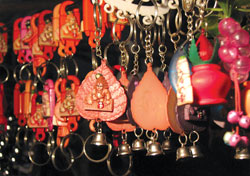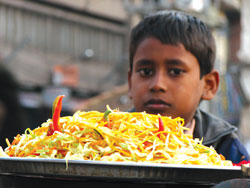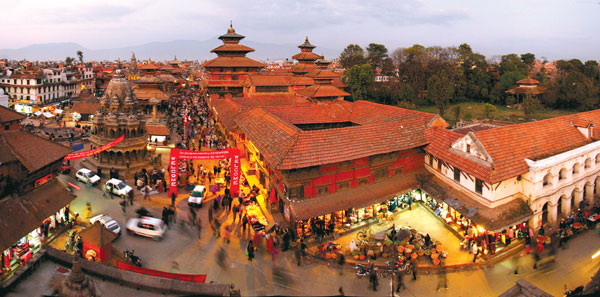As the sun sets behind the hills, Patan's Darbar Square slowly goes back to the people who live around it. The tourists leave and the antique sellers are packing up. The caf?s are seeing an end-of-day spurt and Krishna Mandir, bathed in the light of butter lamps, looks otherworldly. Strains of music waft through and there is laughter and conversation as people gather in groups and talk about their day. Students still in their uniforms snack on peanuts and watch the neighbourhood go by.
These days, though, the crowds are bigger, the teashops have expanded into full-fledged food stalls, and there are vendors of not just vegetables and pote, but everything from electronic goods, to clothing, to books.
Since last summer, a vibrant night market has sprung up here from the southern end of the path leading to Krishna Mandir and all the way down to the waterspout. Vendors like Binita Dulal sell whatever they can get their hands on, leading to interesting product mixes, like the fake designer t-shirts, facecloths, flashlights, table lamps, and battery-operated radios.
|
|
Nearby the Mobile Momo Store has a banner boasting of the best momos and chicken wings in the Valley. Fried sausage, fish, tofu, potatoes, drumsticks, and spring rolls are displayed under a partitioned glass counter. People are gathered four-deep around the stall, and the shopkeeper tells us that more than 150 people eat his food every night. The food is cheap-Rs 10 for sausage-on-a-stick, Rs 5 for roast potato skewers-and relatively fresh because of the high turnover. The oil may be yesterday's, but the meat is not. Basic teastalls cater to those who huddle together to analyse the state of the state.
Purna Kumari Shrestha, who has been selling peanuts at the square for 20 years, thinks the night market is a natural extension of the role the square plays in the lives of Patan residents. "We've gathered around here for a long time, and I have customers who've been buying peanuts from me for years," she says. There is a real camaraderie between Shrestha and her customers. By the light of her lantern, they exchange witty repartee even as off to the side her teenage daughter keeps a sharp eye on the accounts.
 While most people we spoke to thought the market added some much-needed fun to community life, some of the old guard were not quite as happy. Every evening, Krishna Dutta Malla and his friends sit and chat quietly on the benches outside Patan Museum. It used to be peaceful and low-key, but now, he complains, "they sell goods, fry all kinds of meat, and play music in front of a holy place."
While most people we spoke to thought the market added some much-needed fun to community life, some of the old guard were not quite as happy. Every evening, Krishna Dutta Malla and his friends sit and chat quietly on the benches outside Patan Museum. It used to be peaceful and low-key, but now, he complains, "they sell goods, fry all kinds of meat, and play music in front of a holy place."
Since the market came up shortly after Jana Andolan II, the Lalitpur Sub-Metropolitan City, which used to strictly enforce a no-stall rule in front of the old darbar (now Patan Museum) because it is a World Heritage Site, has not paid the vendors a single visit.
Basantapur shows how night markets can be better managed. For the last five years, the Kathmandu Metropolitan City has rented out stalls to vendors on the tiled path leading to the square. Looking down at the market from a nearby highrise is a brilliant sight, and the lights from shops and cars make the bajar look like a long, glowing caterpillar under the shadowy outlines of the old palace. With its neat rows of well-lit stalls, the market is a pleasant contrast to the higgledy-piggledy-albeit atmospheric-mess of Patan's night bajar, though overcrowding is becoming a real danger as cars and motorcycles have free passage through Basantapur.
The vendors here focus on fashion, rather than household appliances. Between the lights of the caf?s and ice cream shops that flank them, the stalls glitter with earrings, hair clips, sunglasses, scarves, trinkets, colourful mirrored bags, Indian slippers, purses, winter coats, shirts, and trousers. It's heaven for street fashion junkies who like to bargain. Young women in particular come to buy clothes imported from Bangkok and China. Bhawana Kandel's jewellery stall, for example, regularly attracts designers and models on the lookout for inexpensive jewellery for photo shoots and fashion shows.
Veteran salesman Susan Pradhan says price is a great attraction here. "We can afford to sell cheap because we save on rent," he explains. Depending on the size of the stalls the vendors pay the municipality up to Rs 3,500 per month.
 Night markets are turning into a fundraising venture too. The JP School in Thamel rents out its grounds to stalls every evening. In exchange, the vendors are to pave the premises. The main attraction here are the bands that play covers of contemporary Nepali rock tunes. The merchandise is similar to that in Basantapur, but a bit more up-to-date-funkier purses, skimpier summer dresses, better cosmetics. It hasn't quite come to life yet, but the vendors are wildly optimistic. "This is the perfect place for an open night market," says stall owner Rosi Gurung. "There is so much space for music, shops, and food, and I bet in a few months this place will be bustling with people."
Night markets are turning into a fundraising venture too. The JP School in Thamel rents out its grounds to stalls every evening. In exchange, the vendors are to pave the premises. The main attraction here are the bands that play covers of contemporary Nepali rock tunes. The merchandise is similar to that in Basantapur, but a bit more up-to-date-funkier purses, skimpier summer dresses, better cosmetics. It hasn't quite come to life yet, but the vendors are wildly optimistic. "This is the perfect place for an open night market," says stall owner Rosi Gurung. "There is so much space for music, shops, and food, and I bet in a few months this place will be bustling with people."



